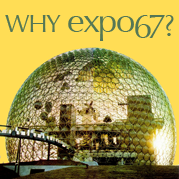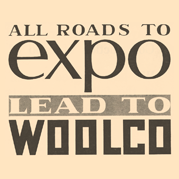expo 67 lounge
Mid-century fashion, vintage pop culture and retro cool... from Expo 67 and beyond.
24 December 2009
2 December 2009
21 November 2009
Expo 67 Department Store Display
 The image above is a rare shot of an Expo 67 promotional display at the now-defunct Denholm & McKay store in Worcester, Massachusetts.
The image above is a rare shot of an Expo 67 promotional display at the now-defunct Denholm & McKay store in Worcester, Massachusetts.Such displays would have been commissioned by the public relations department for Expo 67, to drum up enthusiasm for the upcoming fair.
Check out the ultra-sexy Expo 67 hostess cardboard cutout, below! That, too, was meant to drum up, er... enthusiasm.
 images: (top) flickr.com
images: (top) flickr.com(bottom) montage by author
Labels: expo life, happening hostesses
17 November 2009
The U.S. Pavilion at Night
 A stunning view of the edge of one of the exhibit platforms.
A stunning view of the edge of one of the exhibit platforms.  Huge paintings by well-known American artists adorned the dome's interior.
Huge paintings by well-known American artists adorned the dome's interior. Destination Moon, the pavilion's much-hyped space exhibit.
Destination Moon, the pavilion's much-hyped space exhibit. Life-sized models of satellites and rockets hung on enormous parachutes.
Life-sized models of satellites and rockets hung on enormous parachutes. The Minirail, as it entered the dome.
The Minirail, as it entered the dome. The dark spots were actually retractable screens, used for climate control.
The dark spots were actually retractable screens, used for climate control.photos: Bill Dutfield, via expo67.ncf.ca
Labels: expo life, pavilions-a-gogo
10 November 2009
Fondue and Tabletop Cooking, 1970
 Better Homes and Gardens magazine was first published in 1922 by Edwin Meredith, founder of the Meredith Corporation.
Better Homes and Gardens magazine was first published in 1922 by Edwin Meredith, founder of the Meredith Corporation.Originally called Fruit, Garden and Home, the magazine was renamed Better Homes and Gardens in 1924. By 1930, eager to capitalize on the success of the magazine, Meredith published the Better Homes and Gardens Cook Book. Magazine subscribers received complimentary copies of the first edition, and book sales grew rapidly.
By the mid-20th century, Better Homes and Gardens had established itself as a leading authority on home economics and gardening, with a plethora of specialized books and cookbooks, spun off from the original magazine.
This 1970 edition of Fondue and Tabletop Cooking put together "the most widely acclaimed fondues, from appetizers through desserts", promising that the reader would become "an effervescent, day-by-day fondue hostess."
 Warm appetizers: Cheese-Bean, Sausage-Avocado and Shrimp dips.
Warm appetizers: Cheese-Bean, Sausage-Avocado and Shrimp dips.An intriguing introduction:
"Fondues give menus seemingly new and exciting twists, yet the idea originated long ago. Out of a fervent desire to utilize hardened cheese and bread, the Swiss concocted a mouth watering cheese-wine mixture. The cheese was melted in wine, and the bread cubes were dunked in the mixture. The name 'fondue' came from the French word 'fondre' which means 'to melt'."
 Fish and Seafood Fondue, featuring Salmon, Shrimp and Lobster.
Fish and Seafood Fondue, featuring Salmon, Shrimp and Lobster.Meat magic:
"'Beef Fondue' consists of beef cubes cooked in hot oil and then dipped in a zesty sauce. Similar fondues substitute other meat, fish, or seafood for beef.
"Dinner is easy on the hostess when the main dish is meat, fish or seafood fondue. The hostess sets the table, and the guests do the rest themselves. It's instant fun for everyone."
 Mexi-Meatball fondue... ¡Ay, caramba!
Mexi-Meatball fondue... ¡Ay, caramba!Fondue Fiesta fun:
"Mexican food and music go hand-in-hand, so combine the two with colorful south-of-the-border decorations for a wildly enthusiastic dinner. To an accompaniment of recorded trumpets, guitars, maracas and castanets, serve a snappy 'Mexi-Meatball Fondue', soft tortillas and hot 'Mexican Chocolate'."
 Fondue Italiano, served at a gay after-ski party. Look how happy everyone is!
Fondue Italiano, served at a gay after-ski party. Look how happy everyone is!After-ski amusement:
"Br-r-r-r, it's cold outside - so build a roaring blaze in the fireplace, bring on the fondue, and start swapping skiing tales. If you're not in ski country, plan this "warm up" party to follow some other winter activity."
 Modern, portable appliances, used for tabletop cooking.
Modern, portable appliances, used for tabletop cooking.Tabletop truths:
"The myriad of smartly-styled appliances for tabletop cooking gives the modern homemaker another approach to dining. Some provide sufficient heat to cook table-side; others simply keep foods at serving temperature."
 An electric skillet is used to cook vegetables and shrimp Tempura-style.
An electric skillet is used to cook vegetables and shrimp Tempura-style.Tempura talk:
"Add a far-eastern flavor to dining with Japanese Tempura - batter dipped shrimp and vegetables deep-fat fried in an electric skillet."
Decorating directives:
"Guests will enjoy dining at a low table accompanied with plenty of soft floor pillows. Arrange a black or brightly colord lacquered tray at each place setting - they need not match - or, use bamboo placemeats. Chopsticks add authenticity, although it is wise to furnish knives, forks, and spoons. Provide small cups for warm 'sake' (rice wine)."
 Waffles served with apple, pecan or coconut-orange peel toppings.
Waffles served with apple, pecan or coconut-orange peel toppings.Waffle wisdom:
"Start the day with piping hot wafles for breakfast or wind it up with an ice cream-topped waffle dessert after the theatre. In between are occasions for sophisticated waffle entrées served with cheese, meat or seafood sauce."
 The chafing dish, demystified.
The chafing dish, demystified.Chafing dish chat:
"Ever dream of being a star? Even if your stage aspirations have long been forgotten, dust the cobwebs off that dream. Make your debut at your next dinner party by cooking at the table using a chafing dish. Chafing dish cookery not only caters to the showmanship in all of us, it also enables the hostess to spend her time with guests. They become the supporting players."
Wow, who knew that a chafing dish could do all that...?
 Lemon Crêpes, drizzled with Royal Grape Sauce, and warmed in a chafing dish.
Lemon Crêpes, drizzled with Royal Grape Sauce, and warmed in a chafing dish. Mini Pastries au Fondue
Mini Pastries au FondueDo-it-yourself dessert:
"Guests spear and cook surprise filled pastries. Easy to make, squares of refrigerated crescent-roll dough are sealed around bite-size pieces of fruit or candy."
And, yes, they're fried in oil...!
 images: personal collection
images: personal collectionLabels: far-out food
8 November 2009
Groovy Turcot!
 I just love this ultra-groovy interpretation of the Turcot Interchange, by local artist Henry Buszard...
I just love this ultra-groovy interpretation of the Turcot Interchange, by local artist Henry Buszard...Labels: groovy graphic art
2 November 2009
Expo 67 in One Day
 Only one day to visit Expo 67...? No problem!
Only one day to visit Expo 67...? No problem!From Expo Inside Out, a no-nonsense guide to seeing the best of Expo, in just one day:
"Take the Metro to Sainte-Hélène, arriving at 9:30am. Go immediately to the United States pavilion (you can't miss it); and get in line for the film (which includes the tour). Allow two hours, which means you should be out before 11:30.
 Get in line for the U.S. pavilion first thing in the morning.
Get in line for the U.S. pavilion first thing in the morning."You won't have to wait in line long if you lunch early. Try the restaurant in one of the following pavilions (all a short walk from the U.S.): Scandinavia, Austria, Switzerland, Japan. With care and luck, you will eat well for 5$ each. We'll allow you until 1pm to eat.
"An hour is plenty to take in Japan and will even give you some time to rest in its garden.
 Take the time to rest in Japan's garden.
Take the time to rest in Japan's garden."By 2:30 you should have found your way to the theme pavilion, 'Man the Explorer'. See 'Man and the Polar Regions' and 'Man, his Planet and Space'. By 4:30, you should be out.
"Walk back towards the United States, and turn right at Cosmos Walk, the pedestrian bridge across Le Moyne Channel. (If you're tired, take a Pedicab for about 1$).
 Cross Cosmos Walk, the pedestrian bridge...
Cross Cosmos Walk, the pedestrian bridge... ... or take a Pedicab if you're tired.
... or take a Pedicab if you're tired."Take a good look at the U.S.S.R., but don't go in. Cross Île-Notre-Dame and turn right again, past Mexico and India to Barbados-Guyana, where we suggest you stop and have a drink (our recommendation: BIM BAM BOOM), to the accompaniment of a calypso group and macaws.
 Have a drink at the Barbados-Guyana pavilion.
Have a drink at the Barbados-Guyana pavilion."By 6:00pm, you should be ready for supper in Canada's 'Tundra' restaurant, which is two buildings past the teepee of the Indians of Canada (allow 15$ for two.)
 Have dinner at Canada's Tundra restaurant.
Have dinner at Canada's Tundra restaurant."Try not to miss the last showing of 'A place to Stand' in the Ontario Pavilion (get there by 9pm).
"We wouldn't blame you if your energy has given out, but if you're still going strong, walk over to the Minirail Station opposite the Western Provinces and take the Blue Minirail (a 45 minute ride for 50¢). Don't get off too early - you pass through some stations twice. This is the best time to take the Minirail; you see Expo lit up at night and you won't have to wait in line.
 Take the Minirail at night... it's the best time.
Take the Minirail at night... it's the best time."After that, you may want to visit the Amusement Center (La Ronde). Walk to the Expo-Express Station (Île Notre Dame) and take the Expo Express to La Ronde, at the end of Île Sainte-Hélène. From there you are at the mercy of the barkers and your own impulse to spend money.
 Finish off your day at Expo 67 at La Ronde.
Finish off your day at Expo 67 at La Ronde."To get home, use the La Ronde exit, and take a bus to the Metro (Papineau station) and you're on your way."
images: (1) montage by author
(2-3-8-9) Bill Dutfield
(4) flickr.com
(5) library and archives Canada
(6) personal collection
(7) courtesy DC Hillier
Labels: expo inside out, expo life
26 October 2009
The Château Champlain Hotel
 Artist's conception of the Château Champlain and surrounding area, 1965.
Artist's conception of the Château Champlain and surrounding area, 1965.Designed by Quebec architects Roger D'Astous and Jean-Paul Pothier, the Château Champlain hotel was built in anticipation of the massive influx of visitors expected for Expo 67.
Located just south of Dominion Square, the 480-foot, 38-storey luxury hotel was part of the Place du Canada complex, which included a pedestrian plaza, boutiques, and an office building.
The Château Champlain was built by Canadian Pacific Hotels, a division of the Canadian Pacific Railway, at the cost of $25 million. Construction was completed in late 1966, with the official opening in the spring of 1967, just in time for Expo.
 Close-up view of the hotel's top, with it's ubiquitous arched windows.
Close-up view of the hotel's top, with it's ubiquitous arched windows.The 480-foot tower's facade included 1100 concrete panels, finished in a textured white quartz composite, with 660 of these bowed and arched to frame the Château Champlain's signature curved windows. The arched windows were intended by the designers as a visual reference to the Romanesque Revival arches of nearby historic Windsor Station.
The interior of the hotel was designed with a distinct French Canadian character, a modern blend of old and new.
The hotel's main and lower lobbies, as well as its ballroom, featured cathedral-like vaulted ceilings from which hung contemporary chandeliers. The traditional crystal ballroom, with balconies, could welcome 500 guests for a formal dinner, or 900 for dancing.
Guest rooms were U-shaped, dictated by the architecture, with an arched bay window in each room. A round breakfast table was set in the bay window which was curtained with light and airy drapery. Furniture was simplified as much as possible: a mirrored dressing area in each room provided built-in luggage and clothing storage, forgoing the need for bulky free standing units. Upholstered chairs and ottomans featured modern interpretations of traditional styles. Tasteful accessories such as cushions, lamps and paintings completed the décor.
Rooms on the east side of the hotel had an unobstructed view of Expo 67.
 The office tower (right) was unfinished at the time of this photo (1966).
The office tower (right) was unfinished at the time of this photo (1966).The Château Champlain featured 7 dining rooms and cocktail lounges:
Le Caf' Conc' was built like a turn-of-the-century theatre, recalling the heyday of French cafés-concerts. Included was a full stage, tiered parterre and box seats... adorned with gilt-framed paintings on a backdrop of lush reds, purples, and gold.
Le Café-Terrasse featured sliding doors that opened onto the pedestrian plaza during the warm months. An open kitchen served coffee, crèpes, home-made soups, etc.
Le Tournebroche, as the name suggests, served spit roasted and grilled specialties. The largest of Château Champlain's restaurants featured a décor that recalled an old-style Quebecois auberge. Bread was baked in brick ovens, while a series of alcoves along a 60-foot wall let guests observe the chefs at work. The restaurant also featured a walk-in wine cavern and a special section where cheese and sausage hung from the ceiling.
L'Escapade, the hotel's rooftop entertainment centre, offered a panoramic view of Montreal and its surroundings. 4 split-level sections were linked by vaulted archways, containing 2 à la carte restaurants, as well as a cocktail lounge and nightclub.
Le Jardin, the formal cocktail lounge, featured a winter garden with poodle cut box hedges in marble planters. Vaulted ceilings were painted with a cloud motif, and 5 French doors led to the formal dining room.
Le Neufchâtel was the Château Champlain's formal dining room, and the only area that was decorated in a purely formal manner. À la carte lunches and table d'hôte dinners were enjoyed in ornate Louis XVI style...
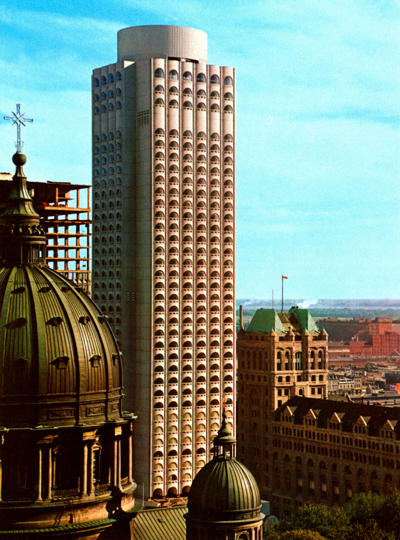 From left: Neighboring Mary Queen of The World Cathedral and Windsor Station.
From left: Neighboring Mary Queen of The World Cathedral and Windsor Station. A decorative windmill on Dominion Square contrasted with the modern hotel.
A decorative windmill on Dominion Square contrasted with the modern hotel. A 1966 view of from Peel Street. Till today, the hotel remains Montreal's tallest.
A 1966 view of from Peel Street. Till today, the hotel remains Montreal's tallest.images: authors own, from Montreal '65 & '66 magazines
Labels: montreal retro
14 October 2009
The Pavilion of Thailand
 The Thai pavilion at Expo 67 was a marvel of classic Eastern architecture. Located on Île Notre Dame, Thailand sought to present an image of traditional grace and refinement, in an atmosphere of oriental beauty.
The Thai pavilion at Expo 67 was a marvel of classic Eastern architecture. Located on Île Notre Dame, Thailand sought to present an image of traditional grace and refinement, in an atmosphere of oriental beauty.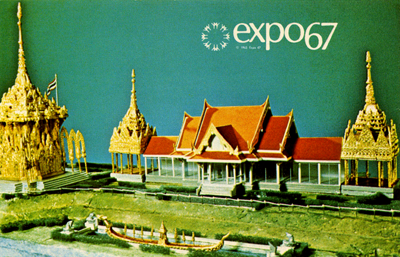 The pavilion's 2 seperate buildings, clearly illustrated by this artist's conception.
The pavilion's 2 seperate buildings, clearly illustrated by this artist's conception.Thailand's participation at Expo 67 was composed of 2 main structures:
The first was a replica of an ornate 18th century Buddhist shrine. A pagoda-like roof was covered in gilded tiles and crowned by a tall, delicate spire. Each tile had a tiny bell suspended from it, meant to tinkle in the breeze and ward of evil spirits.
 Thailand's 18th century Buddhist temple.
Thailand's 18th century Buddhist temple.Inside the shrine, the atmosphere was tranquil. Tall, stained glass windows were flanked by sumptuous red draperies. Religious items, temple furniture, traditional costumes and statues were on display in this area. A magnificent altar of carved wood, adorned by precious stones, was located towards the rear of the shrine. Large pewter vases on the altar held 2 elephant tusks forming an arch from which was suspended a brass gong.
 Long lineups to enter the Buddhist shrine were frequent.
Long lineups to enter the Buddhist shrine were frequent.The second structure of the pavilion was also of traditional architecture, yet considerably larger than the former. It housed a long hall under its gabled roof, flanked on each end by smaller versions of the intricate Buddhist shrine top. As with the temple, red, green and blue lacquer adorned the exterior, with motifs inspired by mythological symbols.
 A closer look at the Thai pavilion's ornate exterior.
A closer look at the Thai pavilion's ornate exterior.Despite the traditional outward appearance, the second building's interior was a tribute to modern Thailand. Remarkable works of craftsmanship were on display: decorative objects such as world-renowned Thai ceramics and porcelains, bronze and silverware, exquisite silks, teak furniture, figurines and costumed dolls, as well as exotic jewelry and precious gems.
 Thai ceramics, considered some of the world's finest.
Thai ceramics, considered some of the world's finest.An area devoted to export products showed different kinds of rice, tapioca and corn, as well as samples of rubber, minerals, and forest products.
The pavilion's boutique offered visitors handmade jewelry, traditional dolls, ceramics, and a vast assortment of lavish Thai silks.
 A Royal Barge was on display outside the pavilion.
A Royal Barge was on display outside the pavilion.In an adjacent pool outside the pavilion floated a replica of a Royal Barge. These vessels were traditionally used in processions of royal and religious significance.



The Thai pavilion, as photographed by Lillian Seymour.
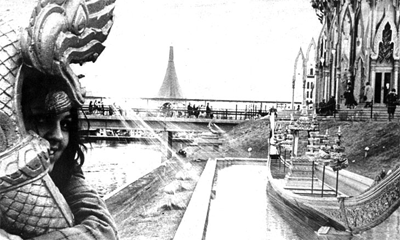 Michèle Richard, posing in front of the Thai pavilion.
Michèle Richard, posing in front of the Thai pavilion.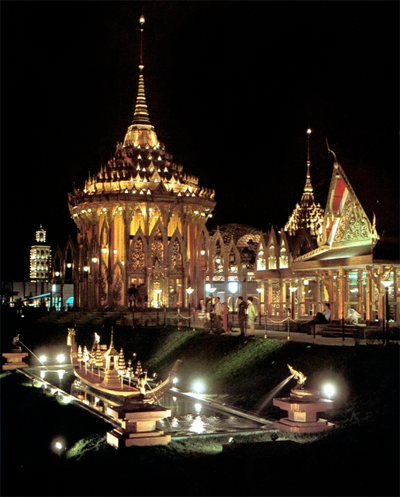 A night view of the Thai pavilion.
A night view of the Thai pavilion. The Thai pavilion at Expo 67 glowed during the day and glittered at night.
The Thai pavilion at Expo 67 glowed during the day and glittered at night. images: (1-2) flickr.com
(3-5-7) Bill Dutfield
(4) gorillasdontblog.blogspot.com
(6-11) personal collection
(9-10) the Lillian Seymour collection
(12-13) courtesy DC Hillier
Labels: pavilions-a-gogo



